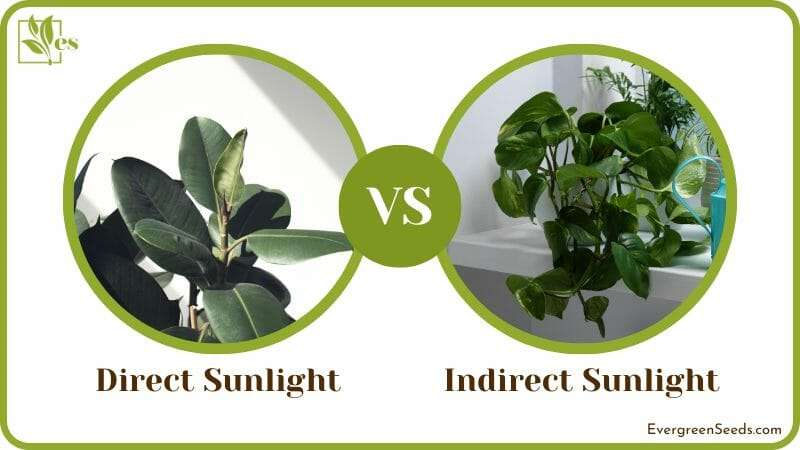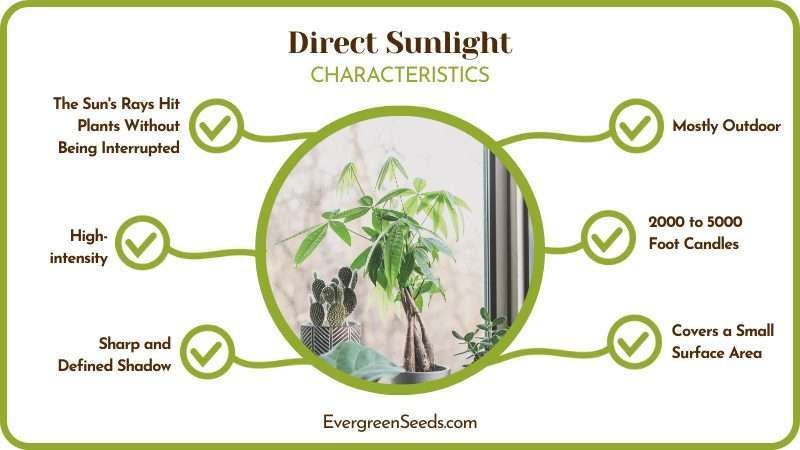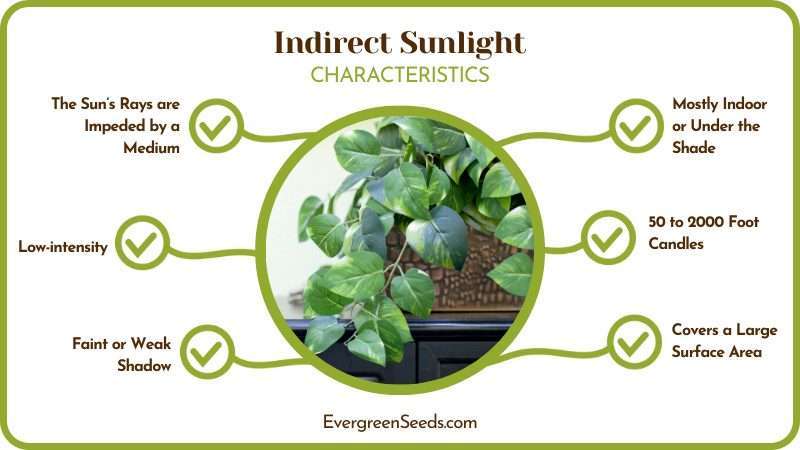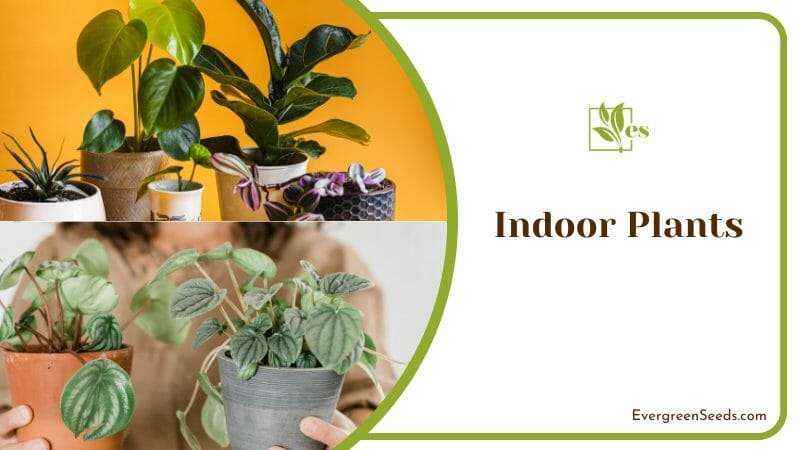Providing direct vs Indirect sunlight might seem to be a difficult task but not at all. After reading this article, you will be able to easily differentiate the two and provide your plants with the relevant light amounts.

This article will present to you all the different features of each type of sunlight. You should be able to determine the spot to place your plant after acquiring more information here.
JUMP TO TOPIC
Comparison Table
The table below shows some differences between direct and indirect sunlight.
| Features | Direct Sunlight | Indirect Sunlight |
| Definition | It hits the earth’s surface or plants without being interrupted | The sun’s rays are impeded by a medium |
| Intensity | High-intensity | Low-intensity |
| Shadow | Sharp and defined | Faint or weak |
| Place | Mostly outdoor | Mostly indoor or under the shade |
| Foot candles | 2000 to 5000 | 50 to 2000 |
| Heat energy | Covers a small surface area | Covers a large surface area |
| Illumination | Provides strong illumination to a specific place | Provides low to moderate illumination to the surrounding area |
What Are the Differences Between Direct Vs Indirect Sunlight?
The main difference between direct and indirect sunlight is that the former provides high-intensity heat than the latter. Direct light can cause dehydration in plants, while indirect sunlight maintains normal levels of transpiration. Direct light can provide better, though more harsh lighting than indirect sunlight.
What Is Direct Sunlight Best For?
The direct sun is the best for outdoor plants as it will boost the rate at which plants grow.

The chloroplasts in plants absorb more light energy for the plant to photosynthesize and produce the food for the plant’s vigorous growth. Light-loving plants like the Dracaena trifasciata thrive in direct sunlight.
– Flowering
Some plants require direct sunlight for them to produce flowers. Such plants include sunflower, petunia, moss rose, and marigold. If such plants are not provided with enough direct light, they will not bloom so they will not be able to beautify your home as they should.
– Alternatives Available
If you stay in regions that get little sunlight or you are in the winter seasons, direct sunlight can be difficult to come by.
Under such circumstances, you can get direct light from other sources like LED light. Using such options makes it possible for you to provide your plant with direct light even when you are growing them indoors, be it in homes or offices.
For houseplants, the direction of the window where you place your plant can determine if the light is direct or not. The south-facing windows are usually the ones that provide direct light to your indoor plant.
There shouldn’t be any barrier like a tree, blinds, or curtain that can provide shade to the window so that it can be considered direct sunlight. In the southern hemisphere, the north facing windows with large glasses are the ones that can provide the direct sun to the houseplants.
The direct light in the morning is also best for a houseplant. Some of the plants that are grown indoors require more light for them to blossom.
Placing the plants in direct sun for a few hours in the morning can be the best option for them to produce flowers and fruits. Foot candles can assist you to determine the spot that can receive direct vs indirect sunlight for plants so that you can position your plant correctly.
– More Even Growth
Plants that are grown under broad and direct sunlight or grow lights are unlikely to have one side lacking exposure to the light source. This also reduces the chances of your plant growing leggy on one side as it tries to reach for the light.
Therefore, this ultimately results in a plant that grows uniformly, thereby saving you from having to constantly prune your plant in a bid to maintain a good shape.
– Increases Humidity Levels
For plants that require higher levels of humidity, direct sunlight can play a crucial role. Think of it this way: the increased evaporation rates that are associated with higher sunlight intensity will increase humidity in the vicinity of the plant.
Suppose, you use a pebble tray to raise humidity levels around your plant. The strategy is more likely to work when more evaporation of the water in the pebble tray takes place. This is more possible when direct sunlight is made available.
– Can be Accessed From Different Spots
The south or west-facing windows provide the most needed bright direct light to plants. The bright light should be provided to plants for six hours or more for it to be called direct sunlight.
The bright direct sun is limited in autumn and spring and you can place the houseplants outside to get the amount of light required to grow healthy.
Houseplants like the spider plant can be placed on the window that faces the east to get the morning bright, direct light. The morning light is not too intense and it is quite good for the plants.
The direct light will disappear in the noontime when it will be overhead and slowly going toward the west. Plants that require medium light should be placed on the east window.
The plant can receive partial direct sunlight when placed along the east-facing wall of your house. The direct sun will be available for a couple of hours in the morning and it will nourish the growing plants. The wall will then block the intense direct sunlight from the south and west.
– Less Hands-On Care for Outdoor Plants
Dealing with direct sunlight requires less hands-on as compared to the indirect one when you are rowing the plants outdoors. When you are caring for plants that require indirect light outdoors, you have to be constantly checking to make sure that they are not receiving direct light.
This requires direct input which you can do away with if you grow plants that are happy under direct exposure to sunlight.
– Disease Prevention
You can take advantage of direct sunlight if you accidentally water the foliage of your plant directly. The water will evaporate off the leaves and stems at a faster rate so the chances of leaf rot are greatly reduced.
What Is Indirect Sunlight Best For?
The indirect sun is best for most houseplants like the devil’s ivy and ambiance lighting. Light requirements differ with the type of plants.
The indirect light is needed by other plants to photosynthesize and bloom. Once those plants are exposed to direct light, the process of manufacturing plant food can be affected.
– Pest and Disease Control
Plants that need indirect sun can also fight pests and diseases if provided with the correct lighting. Considering that excessive sunlight exposure is often associated with high temperatures and humidity levels, some plants can become more vulnerable to some diseases. For instance, too high humidity levels around plants can attract fungal infections like leaf rot.
– For Growing Healthy Plants
Indirect sunlight provides moderate light levels that protect your plants from unwanted symptoms such as yellowing of leaves and etiolation. These signs are usually due to exposure to excessive direct sunlight.

Providing indirect sunlight could be the best preventative measure in such instances. If your plant has already been affected by direct light, exposure to patched sunlight could reverse the situation.
In some instances, direct sunlight can be harsh enough to burn the foliage of your plant. This is especially true when plants are exposed to direct light for longer periods of time.
Based on this, indirect sunlight can save the day! Besides, the bright indirect sun can be the best alternative for those plants that need full sun.
– Protects Plants From Dehydration
Unlike direct sunlight, indirect light protects your plant from excessive dehydration. This is because transpiration increases as the intensity of the sunlight is also elevated.
Therefore, indirect sunlight reduces the rate at which water moves out of your plant through the leaves and stems, thereby protecting your plant from wilting and drooping foliage.
– Better Balance Between Photosynthesis and Respiration
Direct sunlight promotes higher rates of photosynthesis. However, there tends to be an imbalance between photosynthesis and respiration levels when plants are exposed to direct sunlight conditions.
Under indirect sunlight, photosynthesis levels are much lower than they are when the light is direct. However, in the presence of indirect light, plants have enough chance to utilize the products of photosynthesis for respiration.
Remember, it is the process of respiration that produces the energy that your plant requires for other processes that are vital for its survival. Simply put, indirect light creates a better balance between respiration and photosynthesis.
– Less Evaporation From the Plant’s Soil
Water evaporates at a much slower rate when you grow your plants under indirect light exposure. This means that the growth medium for your plant will not dry quickly and so you won’t need to water it more often.
This is quite important for people whose schedules are so tight to the extent that they cannot get enough time for a lot of “hands-on” care. With direct sunlight, the soil can get dry before the plant roots absorb enough water to maintain the healthy growth of the plant.
– Less Hands-On for Indoor Plants
When you are growing plants indoors, indirect sunlight involves less work considering that you won’t need to move your beauty from one spot to the other in the search for light.

Indirect light would need you to constantly move your plant to a position where your plant can receive the light as needed. If your indoor plant can do well with indirect sunlight, you could be better off with less work.
– Easy to Create
Indirect light does not mean that the plant should be in a dark place but it’s only that the sun’s rays won’t be directly reaching the plant.
There should be an obstruction with indirect light where the natural light is filtered before it hits your plant’s leaves. Most windows provide indirect light. Winter heat energy is also called indirect sunlight as the sun is low, colder, and spread out.
A window that is considered to be providing direct light can be covered with a sheer curtain or blinds to provide indirect sun. The north-facing windows provide indirect sun to plants.
The east, west, or south-facing window provides indirect for a few hours of the day. You can change direct light to indirect by placing the plant in a shade or a few feet away from the light-facing window.
Plants on the north-facing spot find it difficult to get light. The plant can only get one or two hours of early morning or late afternoon of the northwest or northeast window. The low-light plants are placed on this spot, for example, the peace lily.
– Easy to Determine
Plants react differently to the indirect sun so you can use the light meter to test the light level in the room. The light meter is more accurate than the smartphone application.
There is bright indirect light that is received by plants placed on a spot that is very close to the east-facing window. The plant like the Zanzibar gem will receive direct sun for less than an hour every day if positioned on this spot before it is filtered.
Medium-light is received by plants that are on a spot that is between the light-facing windows and the back wall.
The light is steady and it is also referred to as the indirect sun. The medium-light can be called dappled light as it is being diffused before reaching the plant. You should always rotate your plants to position them at the right spot as the sun moves.
The window considered direct sun receiver can also provide indirect low light if the plant is placed seven feet or more away from it. The low-light areas can be the ones that do not receive any light from the sun.
Most plants do not like low-light places but they usually adapt to the situation and thrive. If you cannot cast any shadow in low light conditions or even fail to read the newspaper, know that the plants won’t survive also in that space.
– Plants Get Some Rest
During the winter, the intensity of the sunlight is lower and more dappled. Most plants go through a period of dormancy during this period. During this time, the plant will not grow, bloom, or fruit but simply rest and then revamp when the winter period is over. Therefore, indirect light gives your plant some time to rest and rejuvenate itself.












